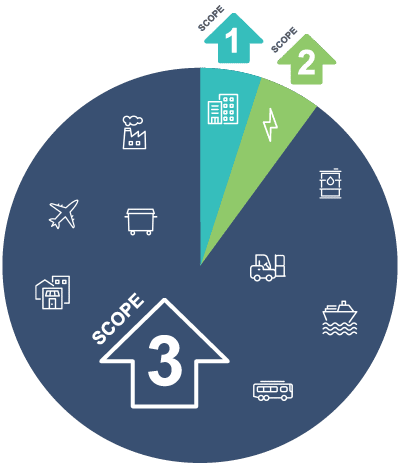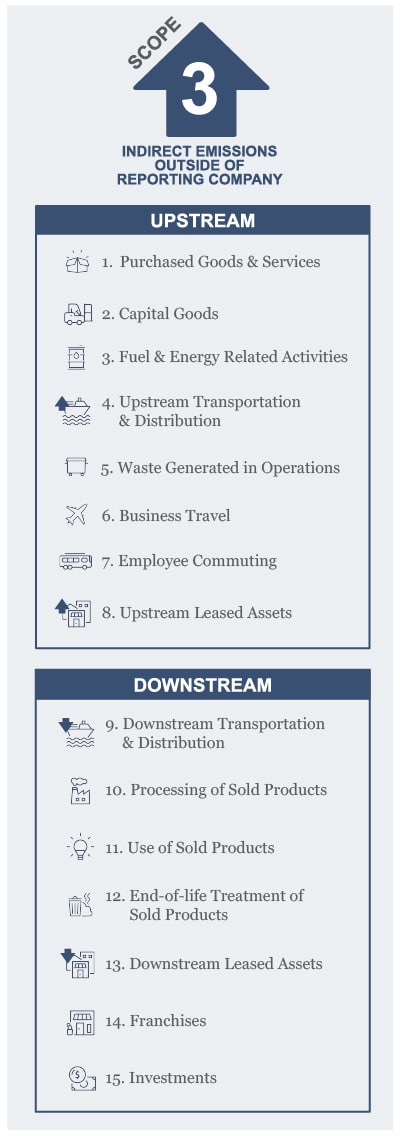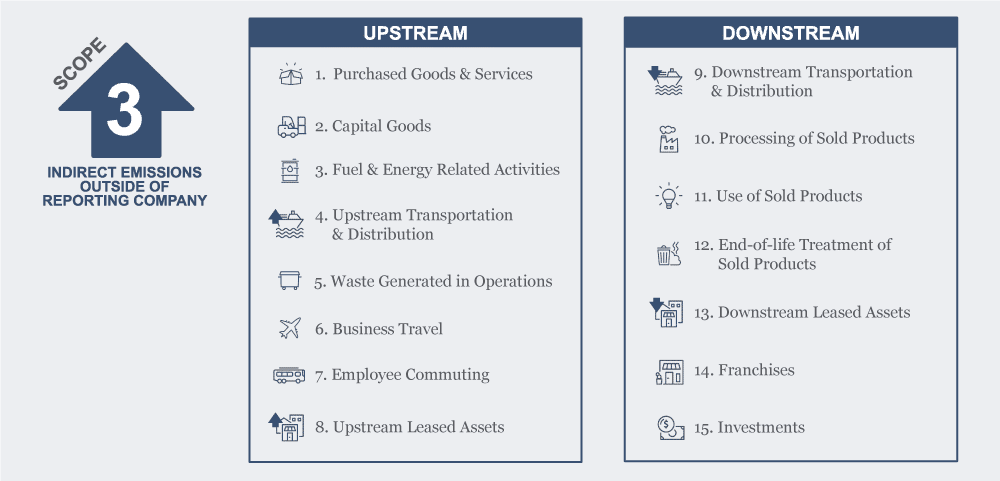
As corporations start on a path to setting sustainability goals and climate targets, understanding current baseline emissions is a critical first step. A comprehensive greenhouse gas (GHG) inventory will offer insights into the specific areas to focus an effective emissions reduction strategy.
Depending on your organization, measuring scopes 1 and 2 emissions can be relatively straightforward as they fall within your direct control and data can typically be more easily accessed. Scope 3 emissions – also known as your value chain emissions – are a bit more complicated. While your company does have some level of influence on Scope 3 emissions, they are outside of your organization’s direct control. Scope 3 emissions typically make up the largest share of an organization’s total emissions because it includes your upstream (supply chain) emissions and those downstream of your organization (customers). Therefore, it is essential to include your scope 3 emissions in your greenhouse gas accounting and climate goals in order to make it credible.
Scope 3 guidance from the Greenhouse Gas Protocol
The Greenhouse Gas Protocol (GHGP) provides the most widely used standard for measuring and reporting scope 3 GHG emissions across 15 categories: the Corporate Value Chain (Scope 3) Standard. This standard provides helpful guidance for measuring scope 3 emissions and – more importantly – it enables uniform measurement and reporting of progress toward climate goals for companies worldwide. While the use of the GHGP’s standard is not mandatory, the majority of organizations follow it to measure and report their emissions.
The first step in measuring scope 3 emissions is gathering the necessary data from various business units within your company and potentially from suppliers. If the data collection required to complete a full scope 3 inventory is overwhelming, a scope 3 screen is a great place to start. Conducting a screen instead of a full inventory allows organizations to start measuring emissions using more readily available data. The resulting insights are less granular than that of an inventory, but reveals which categories have the largest emissions, i.e. your emissions hotspots, so that you know where to focus your efforts for both reduction activities and improving emissions measurement in the future.


In general, emissions are calculated by evaluating your organization’s activities and the carbon intensity of those activities. Depending on what kind of activity data and carbon intensity data is available, you can choose to calculate emissions with primary data or secondary data. Primary data, such as supplier-specific emissions for the activities they perform, is preferred if it is available as it will be more granular and accurate. However, this data is often not available because suppliers have not measured their GHG impacts directly. Many companies use secondary data, such as industry average data, because it is more widely available and accessible. Industry average data applies assumptions about your organization’s activities and emissions factors based on the average emissions within your organization’s industry. Organizations typically start with industry average data and work towards supplier-based data over time, prioritizing collection of primary data for hotspot categories first.
You will need to work across various teams to collect and collate the right data. Some categories may be easier than others to gather the required data. For example, you may have direct access to the internal systems and sources for some categories (e.g. travel booking software for business travel) while other categories will require engaging with other business units and/or your suppliers to acquire data. Where supplier-specific data is lacking, there are public databases such as US EPA, ADEME, and DEFRA that offer industry-average emissions factors that can be used to estimate your emissions.
Once you’ve gathered your emissions data for each of the scope 3 categories, you will have a baseline of your scope 3 emissions footprint that you can use to plan and prioritize your reduction initiatives.
Using your greenhouse gas inventory to build your reduction plan
The biggest challenge with scope 3 reduction planning is that your organization does not have direct control over these activities. While there are reduction programs that you can implement immediately to reduce emissions in your scope 3, such as switching to less carbon-intensive products or putting a cap on employee travel, it will be imperative to work closely with your internal and external stakeholders to develop a robust plan. Your organization’s partners, suppliers, and employees will all need to be involved in order for your business to make impactful reductions. This is why a thoughtful supplier engagement strategy is a cornerstone of your overall reduction strategy.
To help narrow your focus and determine which reduction programs to prioritize, your organization can apply a multi-prong approach:
- Prioritize reductions in the scope 3 categories with the highest volume of emissions
- Consider reduction programs that align with your unique business objectives
- Choose to highlight reduction programs that engage employees to build buy-in
Each organization’s emissions reduction plan will look different, but developing a strategy based on data will allow you to engage the right stakeholders at the right time to begin making meaningful changes.
Make scope 3 greenhouse gas accounting a priority
Tracking and addressing value chain emissions is undoubtedly a complex process. Furthermore, standards, requirements, and carbon accounting software tools are rapidly evolving. As it typically makes up the vast majority of an organization’s emissions, it is essential to understand who and what constitute your value chain. This is why scope 3 GHG accounting is a foundational starting point for building your organization’s broader climate strategy and emissions reduction goals.
If you’re interested in understanding your organization’s scope 3 footprint or learning more about scope 3 GHG accounting, we offer advanced training and support, so contact us today.


